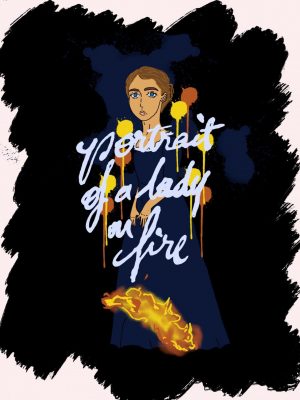Paranormal Romance Has More to Offer Than Shirtless Vampires
Stop vilifying a genre dedicated to overcoming biases and prejudice
Paranormal romance novels should be judged for their content, not their covers.
July 20, 2021
“Jesus Christ, Em, you’re reading that?” my parents had always proclaimed when they stared at the pile of books in my arms as I came back from the library. Most of the books had shirtless men on the covers, with wings and fangs and the brooding outline of a city skyline behind them.
The covers are atrocious, I’ll give them that. No parent wants to see their teenage daughter reading such obvious trash. But that’s the kicker: Paranormal romance books are rarely, if ever, complete trash.
The traditional arc of a paranormal romance novel follows a young heroine, often mortal, who crosses paths with a supernatural creature of some sort. Vampires and werewolves are popular choices — somewhat inspired by the success of the “Twilight” franchise — but it’s not uncommon to encounter elves and warlocks and golems as well. These creatures, often dark-haired men with dangerous pasts and disturbingly low self-esteem, fall in love with the hapless mortal, leading the couple to moments of risk and adventure.
Quite a lot of complexity can be hidden under wings and claws.
On the surface, these books seem frivolous. The sarcastic one-liners and cheesy battle subplots are compulsively enjoyable. But there is more to the books than meets the eye — quite a lot of complexity can be hidden under wings and claws.
To start, the paranormal romance genre flips the concept of a monster on its head. While most of the books feature traditional horror characters, such as vampires or demons or werewolves, these beings are rarely, if ever, truly evil. While some paranormal romance books embrace the villainous nature of these monsters, most authors choose to do the opposite.
Take “Twilight’s” Edward, for example. He’s a vampire who doesn’t eat people. A monster who sacrifices his happiness to protect the people he loves. By taking a horror figure and personifying it, paranormal romance books force the reader to reevaluate their understanding of what makes a monster and how they judge people according to their identity.
Anyone capable of falling in love can gain love in return.
The monsters who are not monsters have to hide from a cruel and violent society. They face discrimination and oppression for their identity, but they find ways to become empowered regardless. The monsters who are not monsters survive in a world built to destroy them because they use their most powerful weapon — love. Anyone capable of falling in love can gain love in return. In fact, in a paranormal romance novel, your soulmate might teach you just how powerful love can be.
Call me a hopeless romantic, but there is an incredible beauty in that.
Paranormal romance novels can even go deeper than that. Popular paranormal romance authors such as Kresley Cole, and, more recently, Ruby Dixon place a strong and likable heroine at the center of their stories. While most romance books end with a couple forming or a baby being born, paranormal romance books generally cover a wider scope of time. In paranormal romance books, the story does not end when the heroine meets someone she is going to love — in fact, that often occurs almost immediately.
Avoiding paranormal romance books because you look down upon the monstrous men on the cover makes you no better than the villains in the books.
The authors choose to include a romance plot within the structure of a larger and more complex fantasy world in order to give the heroine a sense of agency and power. While many romance novels do this as well, paranormal romance novels have the added benefit of magic to add a second layer of complexity to the romantic and fantastical elements of the work.
Individuals scorn paranormal romance books frequently. They get labeled as trashy because the covers are overtly sexual and, I’ll admit it, often pretty funny. However, that doesn’t take away from the joy and magic of the books themselves.
Society mocks paranormal books for painting monsters as beings worthy of love. When people see a vampire on the cover, they laugh at the naivete of structuring a world where monsters are beautiful, intelligent and misunderstood.
Avoiding paranormal romance books because you look down upon the monstrous men on the cover makes you no better than the villains in the books. When you read paranormal romance, you are able to embrace the ultimate reading cliché and judge a book by its contents rather than its cover.
All romance novels face the stigma of being overly dramatized and pornographic depictions of a woman’s fantasy. While it is true that much of the paranormal romance genre features smutty scenes, the books are anything but porn. Often, the sex depicted in paranormal books includes supernatural elements that further develop the world-building of the novel.
In some cases, it might be part of a mating ritual. In others, it might solidify a magical bond that both empowers and connects the characters. While there are many novels that choose to fade to black, there are just as many that embrace the sexual aspect of the genre and utilize it as a tool in their storytelling.
Furthermore, other genres in literature feature sexual content. In fact, it is difficult to pick up a book that does not feature some sexual material. When popular novels include sex, they are not labeled as pornographic or stigmatized for their material. So what’s the difference between other genres and romance? The difference is that 84% of romance readers are women.
Paranormal romance novels get maligned as an unrealistic female fantasy, but there is a reason that women are so drawn to them. Maybe it’s time for society to stop shaming paranormal romance books as stupid and instead focus on the unfulfilled desires of the women who are reading them.
I understand that paranormal romance books might not be everyone’s cup of tea. As much as I applaud its complexity, I recognize that, at the end of the day, the men in the books have tails and wings. But they are not silly monster stories.
They are complicated, beautiful, often insightful monster stories, and they deserve respect.

















